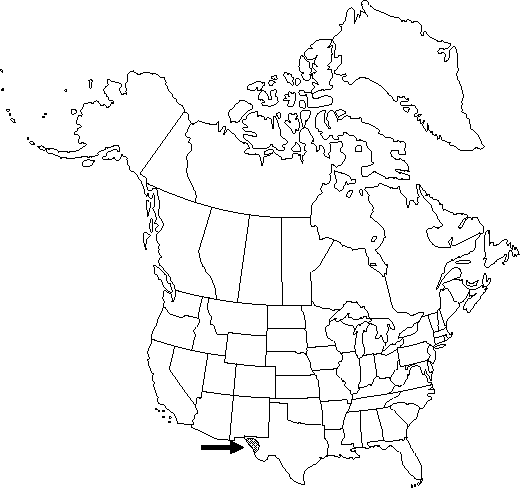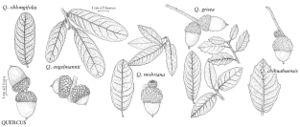Difference between revisions of "Quercus chihuahuensis"
Mem. Natl. Acad. Sci. 20: 85. 1924.
FNA>Volume Importer |
FNA>Volume Importer |
||
| Line 14: | Line 14: | ||
|basionyms= | |basionyms= | ||
|synonyms={{Treatment/ID/Synonym | |synonyms={{Treatment/ID/Synonym | ||
| − | |name= | + | |name=Quercus infralutea |
|authority=Trelease | |authority=Trelease | ||
| − | }}{{Treatment/ID/Synonym | + | }} {{Treatment/ID/Synonym |
| − | |name= | + | |name=Quercus jaliscensis |
|authority=Trelease | |authority=Trelease | ||
| − | }}{{Treatment/ID/Synonym | + | }} {{Treatment/ID/Synonym |
| − | |name= | + | |name=Quercus santaclarensis |
|authority=C. H. Muller | |authority=C. H. Muller | ||
}} | }} | ||
| Line 37: | Line 37: | ||
|elevation=400-2000 m | |elevation=400-2000 m | ||
|distribution=Tex.;Mexico (Chihuahua;Sonora;Zacatecas;and San Luis Potosí). | |distribution=Tex.;Mexico (Chihuahua;Sonora;Zacatecas;and San Luis Potosí). | ||
| − | |discussion=<p>Quercus chihuahuensis is a distinctive species throughout its range, mostly in dry montane western Mexico; it occurs in the United States only as putative hybrids with Q. grisea (the Eagle and Quitman mountains) and Q. arizonica (Hueco Tanks) in Texas.</p> | + | |discussion=<p><i>Quercus chihuahuensis</i> is a distinctive species throughout its range, mostly in dry montane western Mexico; it occurs in the United States only as putative hybrids with <i>Q. grisea</i> (the Eagle and Quitman mountains) and <i>Q. arizonica</i> (Hueco Tanks) in Texas.</p> |
|tables= | |tables= | ||
|references= | |references= | ||
| Line 50: | Line 50: | ||
|rank=species | |rank=species | ||
|parent rank=section | |parent rank=section | ||
| − | |synonyms= | + | |synonyms=Quercus infralutea;Quercus jaliscensis;Quercus santaclarensis |
|basionyms= | |basionyms= | ||
|family=Fagaceae | |family=Fagaceae | ||
| Line 61: | Line 61: | ||
|publication year=1924 | |publication year=1924 | ||
|special status=Selected by author to be illustrated | |special status=Selected by author to be illustrated | ||
| − | |source xml=https://jpend@bitbucket.org/aafc-mbb/fna-data-curation.git/src/ | + | |source xml=https://jpend@bitbucket.org/aafc-mbb/fna-data-curation.git/src/8f726806613d60c220dc4493de13607dd3150896/coarse_grained_fna_xml/V3/V3_607.xml |
|genus=Quercus | |genus=Quercus | ||
|section=Quercus sect. Quercus | |section=Quercus sect. Quercus | ||
Revision as of 17:18, 18 September 2019
Shrubs or trees, deciduous, to 10 m. Bark gray, furrowed, checkered, or scaly. Twigs gray, 2-3(-4) mm diam., densely tomentose. Buds reddish brown, broadly ovoid, distally rounded, 2-2.5 mm, densely yellowish pubescent; scales gray-puberulent; stipules persistent, 1-4, subulate, pubescent, at base of terminal buds. Leaves: petiole 3-5(-8) mm. Leaf blade elliptic or oblong to ovate or obovate, (25-)40-50(-85) × (18-)20-30(-50) mm, base rounded or shallowly cordate, margins entire or toothed to sublobate, secondary veins 8 to 10 on each side, somewhat branching, apex broadly rounded to acute; surfaces abaxially yellowish or grayish, densely stellate with velvety hairs, adaxially green, sparsely soft-pubescent with prominent, spreading, stellate hairs, felty to touch, secondary veins somewhat prominent on both surfaces, even under dense tomentum. Acorns 1-3 on tomentose peduncle 15-35(-60) mm; cup hemispheric, 7-10 mm deep × 10-15 mm wide, enclosing 1/2 nut, scales proximally thickened, distally appressed, densely gray-puberulent, tips reddish, ultimately glabrate; nut ovoid, 14-18 × 10-12 mm, puberulent, eventually glabrate. Cotyledons connate.
Phenology: Flowering spring.
Habitat: Oak and pinyon-juniper woodlands, grassy hills, sometimes extending into dry thorn scrub and bursera woodland (Mexico)
Elevation: 400-2000 m
Distribution

Tex., Mexico (Chihuahua, Sonora, Zacatecas, and San Luis Potosí).
Discussion
Quercus chihuahuensis is a distinctive species throughout its range, mostly in dry montane western Mexico; it occurs in the United States only as putative hybrids with Q. grisea (the Eagle and Quitman mountains) and Q. arizonica (Hueco Tanks) in Texas.
Selected References
None.
